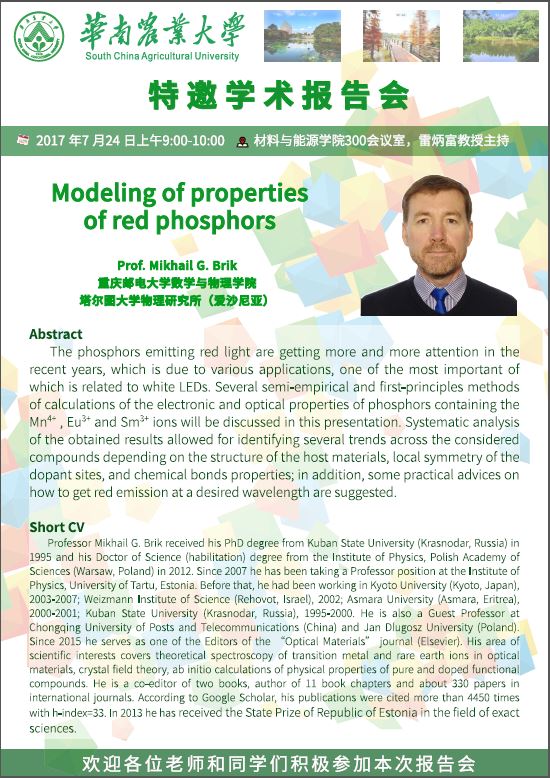报告题目:Modeling of properties of red phosphors
报告人:Mikhail G. Brik 教授
时 间:2017年7月24日(星期一) 9:00
地 点:英国威廉希尔公司300会议室
主持人:雷炳富 教授
报告摘要
The phosphors emitting red light are getting more and more attention in the recent years, which is due to various applications, one of the most important of which is related to white LEDs. Several semi-empirical and first-principles methods of calculations of the electronic and optical properties of phosphors containing the Mn4+ [1-3], Eu3+ [4-5] and Sm3+ [6] ions will be discussed in this presentation. Systematic analysis of the obtained results allowed for identifying several trends across the considered compounds depending on the structure of the host materials, local symmetry of the dopant sites, and chemical bonds properties; in addition, some practical advices on how to get red emission at a desired wavelength are suggested.
References:
1. M.G. Brik, A.M. Srivastava, J. Lumin. 133 (2013) 69.
2. M.G. Brik, S.J. Camardello, A.M. Srivastava, ECS J. Solid State Sci. & Technol. 4 (2015) R39.
3. M.G. Brik, S.J. Camardello, A.M. Srivastava, N.M. Avram, A. Suchocki, ECS J. Solid State Sci. & Technol. 5 (2016) R3067.
4. R.M. Krsmanović, Z. Antić, B. Bartova, M.G. Brik, M.D. Dramićanin, Ceram. Inter. 38 (2012) 1303.
5. M.G. Brik, Ž.M. Antić, K. Vuković, M.D. Dramićanin, Mater. Trans. 56 (2015) 1416.
6. C.-G. Ma, M.G. Brik, V. Kiisk, T. Kangur, I. Sildos, J. Alloys Compds. 509 (2011) 3441.
报告摘要
The phosphors emitting red light are getting more and more attention in the recent years, which is due to various applications, one of the most important of which is related to white LEDs. Several semi-empirical and first-principles methods of calculations of the electronic and optical properties of phosphors containing the Mn4+ [1-3], Eu3+ [4-5] and Sm3+ [6] ions will be discussed in this presentation. Systematic analysis of the obtained results allowed for identifying several trends across the considered compounds depending on the structure of the host materials, local symmetry of the dopant sites, and chemical bonds properties; in addition, some practical advices on how to get red emission at a desired wavelength are suggested.
References:
1. M.G. Brik, A.M. Srivastava, J. Lumin. 133 (2013) 69.
2. M.G. Brik, S.J. Camardello, A.M. Srivastava, ECS J. Solid State Sci. & Technol. 4 (2015) R39.
3. M.G. Brik, S.J. Camardello, A.M. Srivastava, N.M. Avram, A. Suchocki, ECS J. Solid State Sci. & Technol. 5 (2016) R3067.
4. R.M. Krsmanović, Z. Antić, B. Bartova, M.G. Brik, M.D. Dramićanin, Ceram. Inter. 38 (2012) 1303.
5. M.G. Brik, Ž.M. Antić, K. Vuković, M.D. Dramićanin, Mater. Trans. 56 (2015) 1416.
6. C.-G. Ma, M.G. Brik, V. Kiisk, T. Kangur, I. Sildos, J. Alloys Compds. 509 (2011) 3441.
Brik教授简介
Professor Mikhail G. Brik received his PhD degree from Kuban State University (Krasnodar, Russia) in 1995 and his Doctor of Science (habilitation) degree from the Institute of Physics, Polish Academy of Sciences (Warsaw, Poland) in 2012. Since 2007 he has been taking a Professor position at the Institute of Physics, University of Tartu, Estonia. Before that, he had been working in Kyoto University (Kyoto, Japan), 2003-2007; Weizmann Institute of Science (Rehovot, Israel), 2002; Asmara University (Asmara, Eritrea), 2000-2001; Kuban State University (Krasnodar, Russia), 1995-2000. He is also a Guest Professor at Chongqing University of Posts and Telecommunications (China) and Jan Dlugosz University (Poland). Since 2015 he serves as one of the Editors of the “Optical Materials” journal (Elsevier). His area of scientific interests covers theoretical spectroscopy of transition metal and rare earth ions in optical materials, crystal field theory, ab initio calculations of physical properties of pure and doped functional compounds. He is a co-editor of two books, author of 11 book chapters and about 330 papers in international journals. According to Google Scholar, his publications were cited more than 4450 times with h-index=33. In 2013 he has received the State Prize of Republic of Estonia in the field of exact sciences.


